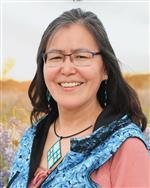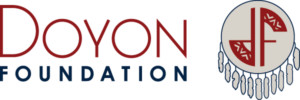
“There is no greater joy than watching children have fun learning their language”
Susan Paskvan se’ooze’ dehoon Denaakk’e hełde K’etsoo seeznee. Sedełnekkaa Eliza yeł Benedict Jones, Sr. hebe’ooze’. Eenaa’e bedełnekkaa setsoo kkaa Josie yeł Little Peter yeł hegheelaa’ee. Eetaa’e bedełnekkaa setsoo kkaa Jessie yeł Harry Jones yeł Andrew Edwin yeł hegheelaa’ee. Toneedze gheltseełne hʉt’aan eslaanh. Meneelghaadze T’oh hʉts’e tsaadaanslet ts’uh Fairbanks lesdo. Seyełledoyee Steve Paskvan. Keel kkaa neeteehne hoolaanh. Jason yeł Adam yeł hebe’ooze’. Denaakk’e yeł Benhti Kokht’ana Kenaga’ hedohʉdege’eeh dehoon hedok’ʉhdeł’eeghenh eslaanh.
My name is Susan Paskvan while in Denaakk’e they call me K’etsoo. My parents are Benedict and Eliza Jones. My mom’s parents are my late grandparents Josie and Little Peter. My dad’s parents are my late grandparents Jessie Edwin and late grandfathers Harry Jones and Andrew Edwin. I am of the Middle of the Stream Clan. I am from Koyukuk but live in Fairbanks. My husband is Steve Paskvan. We have two sons. Their names are Jason and Adam. I am learning Denaakk’e and Benhti while I am also a language teacher.
K’etsoo Susan Paskvan is the Native language coordinator for the Yukon-Koyukuk School District (YKSD), comprising a correspondence program and 10 village schools that dot the Yukon, Koyukuk and Tanana river systems. A Doyon Foundation scholarship recipient, Susan graduated from the University of Alaska Fairbanks (UAF) in 1988 with a bachelor’s degree in business administration and is pursuing a master’s degree at UAF in linguistics and Alaska Native languages. She was awarded a shareholder of the year award from Doyon, Limited and the Alaska Federation of Natives for dedication to heritage languages.
The YKSD serves an area larger than Washington state and encompasses three Alaska Native languages: Denaakk’e, Denaakk’a and Inupiaq. Eight village schools are off the road system. Virtually all children enrolled in the village schools are Athabascan. Susan’s languages are Benhti Kokhut’ana Kenaga’ (Lower Tanana) and Denaakk’e (Koyukon).
Doyon Foundation: How did your language learning begin? How did it become your life’s work?
K’etsoo Susan Paskvan: When I was growing up, we learned household words and phrases – nok’eedonh for “time to eat,” and onee’ “come here.” Then at UAF I took two years of language classes with my mother, so I gained a lot of vocabulary and a strong foundation in the grammar of our language. In 1999, I started as an apprentice with Madeline Williams and my sole job was to learn Denaakk’e with her for two years. I learned how to listen and to practice though my ear instead of writing things down all the time.
I led a summer institute for three years at UAF for teachers and that led to my YKSD job in 2003. I work with a language team, including teachers and Elders, and develop curriculum based on what the team wants the children to learn. The team decided what the children should learn to say in both Denaakk’e and Benhti for the workbook that we developed. I teach classes in 18 different classrooms across the YKSD region. Before pandemic restrictions, I traveled to each of the 10 village schools at least once every semester.
DF: You’re also committed to language beyond the classroom. How did that come about?
KSP: My hope is to get language revitalization going in the community, within tribes and with parents. With only 30 minutes a day for language learning in the classroom, it’d take a long time to become fluent.
I’ve learned that adults want to know at least two things: How to introduce themselves in the language and how to sing the traditional memorial songs. The songs are composed to honor a deceased loved one and sung at a memorial potlatch. Some of the old songs have “high language,” full of poetry, riddles and metaphors. Instead of saying, “He was a good hunter,” the song might say, “He laid down his bow and arrow here,” alluding to the place where he camped and hunted.
Memorial songs are meant to lift you up. It’s a great source of cultural pride when people can sing their traditional songs. To help with that, I’ve done workshops in the villages to get those songs recorded, transcribed and translated. We have a nice collection and hope someday to publish a songbook. I’ve also made the audio files available and digitized them for CDs.
DF: So much of your dedication stems from the work of your mother, Eliza Jones, the University of Alaska teacher of Denaakk’e, and your aunt, Madeline Williams of Hughes, the Tanana Chiefs Conference teacher whom you apprenticed with. What is the role of venerated Elders like your mother and aunt in language learning today?
KSP: The Elders have always told me, “Never give up.” They understand that passing on the language depends on people being encouraged to pick it up. “Never give up” means recognizing that the biggest challenge is in finding learners. And for those learners, it means having enough time.
I think what’s meant by “never give up” is a recognition that learning takes a motivated person who’s passionate about the language and accepts that the more you learn, the more you realize what you don’t know.
DF: You’re saying that students must learn to accept mistakes.
KSP: Yes. I’ve made mistakes and I’ll continue to make mistakes. I’m always learning spelling! But you just have to keep going.
Some of the reluctance, I think, among people in their 60s and 70s comes from boarding school experience when students were punished for speaking their language. They need healing. Gauging a person’s readiness to learn the language is part of the challenge. Learning can be very difficult if teaching isn’t done in a way where it feels safe to make mistakes.
DF: A goal you’ve set for yourself is to become fluent in Denaakk’e. What are attributes of fluency? How does your study of linguistics fit in?
KSP: Linguistics is a scientific way of understanding every aspect of language, including meaning and use. If I’m meeting with language speakers and we’re talking about tanning furs and if I have some kind of linguistics then I understand how context could help me figure out the names of things like tools, fur, membrane and the actions that people are taking.
Being able to pray in the language, to compose songs in the language — these are top-level fluency skills. I’m not there yet, but mother is. She’s 83 and we talk several times a week. I’m a language teacher, but I’m also learning. I encourage people to just start small, to have success with what you’re learning and practice with people, and then just keep adding on.
My mother’s first language was Denaakk’e. She was born in Cut-Off and traveled with her family to different camps. The family moved to Fairbanks in 1970 where she started her work with linguist Michael Krauss, then director of UAF’s Alaska Native Language Center. The linguists had all these questions for my mother and when she’d ask, “What are you working on?” they’d say iterative grammar or another technical aspect of language. Then she’d have them teach her too. Iteration refers to the structure of a verb.
She learned all that. She became a linguist herself while working with speakers throughout the region, documenting their stories and genealogy and place names. She worked 20 years at UAF to document Denaakk’e and in 2000, she shared authorship on the Koyukon Athabascan Dictionary with the Rev. Jules Jetté who began work on the dictionary draft when he came to Alaska in 1898.
DF: Now that’s an example of never giving up.
KSP: Because of all the language and knowledge that Elders have shared with me over the years, because of my mother’s work at UAF, I have a responsibility to pass this knowledge on. I read every day in Denaakk’e, I lead video-conference teaching sessions. It’s a matter of carrying on my mother’s work.
DF: You believe that language learning is a way of being shaped by the culture. What’s an example that comes to mind?
KSP: When you learn your language, you really get grounded. When I teach our origin stories and songs, students learn our beliefs about birds and animals and plants.
In a Zoom group recently we were talking about feelings. We were learning phrases — “I feel tired, I feel happy, I feel sad.” Then we came to ebaa. It means “ouch” or “I’m sick,” but we also teach young students not to say this word because we don’t want them to grow up complaining about a lot of aches and pains. That’s just one example of learning culture through the language.
DF: Where is your commitment to language learning leading you? What’s on the horizon?
KSP: In addition to becoming fluent in Denaakk’e, I would really like to develop a community digital archive of the language. My goal is to get the stories, songs, etc. that are in audio files and make it useable by language learners. And I want to have an institute to start an immersion school for children. There really is no greater joy than watching children have fun learning their language.
About Doyon Languages Online
Through the Doyon Language Online project, Doyon Foundation is developing introductory online lessons for Benhti Kokhut’ana Kenaga’ (Lower Tanana), Deg Xinag, Denaakk’e (Koyukon), Dihthaad Xt’een Iin Aanděeg’ (Tanacross), Dinak’i (Upper Kuskokwim), Dinjii Zhuh K’yaa (Gwich’in), Hän, Holikachuk and Nee’aanèegn’ (Upper Tanana).
The project officially launched in summer 2019 with the first four courses, now available for free to all interested learners.
Doyon Languages Online is funded by a three-year grant from the Administration for Native Americans (ANA), awarded in 2016, and an additional three-year grant from the Alaska Native Education Program (ANEP), awarded in 2017.
About the Language Champion Profile Series
As Doyon Foundation continues to grow our language revitalization efforts in the Doyon region, we believe it is important to recognize people who are committed to learning and perpetuating their ancestral language. We are pleased to share some of these “language champion” profiles with you.
If you know a language champion, please nominate him or her by contacting our language program director at [email protected]. Language champions may also complete our profile questionnaire here.
You may learn more about our language revitalization program on our website, or sign up to access the free Doyon Languages Online courses here.
